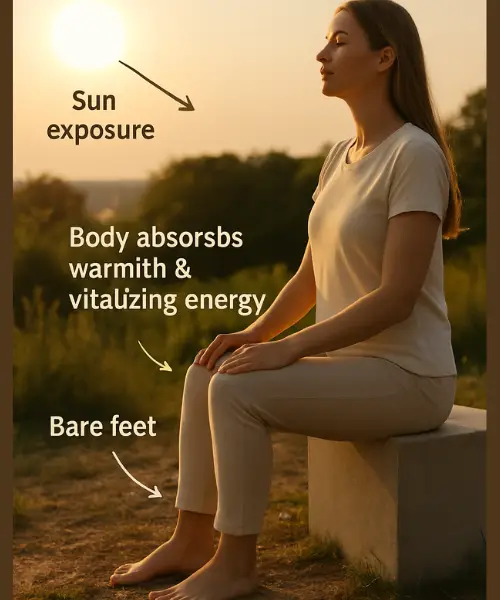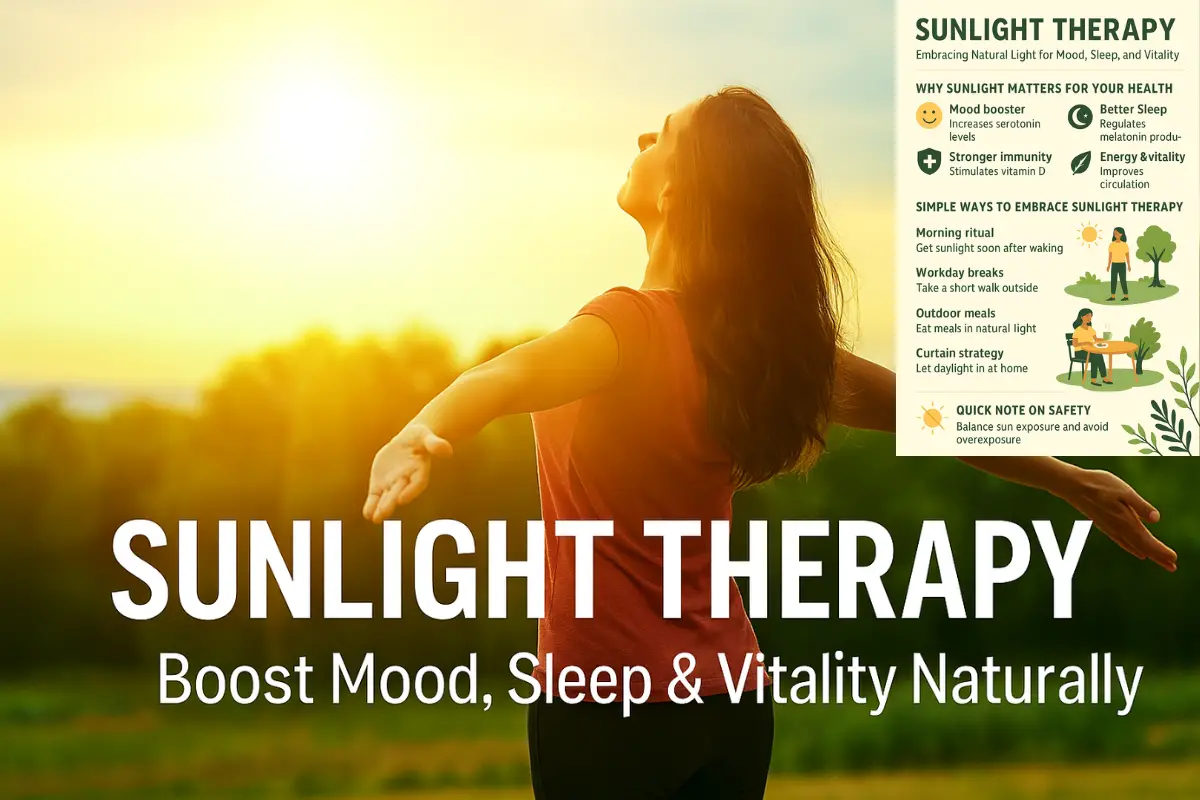Sunlight Therapy: Embracing Natural Light for Mood, Sleep, and Vitality
Introduction
Modern life has distanced us from one of the most powerful healing forces available: sunlight. With more time spent indoors, under artificial lighting, many people experience fatigue, low mood, poor sleep, and weakened immunity. Yet sunlight, a free and abundant natural resource, has been revered across cultures and is now backed by science as a vital element for well-being.
Sunlight therapy, also called heliotherapy, is the intentional use of natural light to improve mental, emotional, and physical health. It is simple, accessible, and deeply effective. In this article, we’ll explore its benefits, history, scientific foundation, practical applications, and tips for safe integration into daily life.
The Ancient Wisdom of Sunlight
Long before modern medicine, ancient civilizations understood the importance of sunlight.
- Ancient Egyptians worshipped Ra, the sun god, and used sunlight for healing rituals.
- Greeks and Romans built sunlit courtyards where patients could recover in natural light.
- Indian Ayurveda emphasized early morning sun exposure for balance of body and spirit.
- Chinese medicine viewed sunlight as a vital source of “Qi,” the life energy.
Even without scientific knowledge, people instinctively knew the sun was more than just warmth — it was life itself.
The Science of Sunlight and Health
Today, science confirms what ancient cultures practiced. Sunlight influences almost every system in the body.
1. Mood Regulation
Sunlight exposure increases serotonin, the neurotransmitter that stabilizes mood, reduces anxiety, and supports happiness. This is why time outdoors often makes us feel calmer and uplifted. Lack of sunlight, especially in winter, can trigger Seasonal Affective Disorder (SAD).
2. Circadian Rhythm and Sleep
Our bodies are programmed to follow the natural light-dark cycle. Morning sunlight signals the brain to suppress melatonin (the sleep hormone) and activate cortisol for wakefulness. As evening approaches and light fades, melatonin rises, preparing us for sleep. This rhythm, called the circadian cycle, is essential for deep, restorative rest.
3. Vitamin D Production
Sunlight triggers the skin to produce vitamin D, often called the “sunshine vitamin.” Vitamin D supports:
- Strong bones and teeth
- Healthy immune function
- Reduced inflammation
- Lower risk of certain chronic diseases
Deficiency in vitamin D has been linked to fatigue, depression, and increased illness.
4. Energy and Vitality
Exposure to sunlight improves blood circulation and oxygen delivery throughout the body. Many people describe feeling recharged and more energetic after even short time outdoors.
5. Hormonal Balance
Sunlight impacts hormones beyond melatonin and serotonin. It influences dopamine (motivation), endorphins (pleasure), and even sex hormones. Balanced hormone levels are key to physical and emotional well-being.
Proven Benefits of Sunlight Therapy
- Boosts mental health – reduces depression, anxiety, and stress.
- Enhances sleep – aligns circadian rhythm, improves sleep quality.
- Supports immune system – vitamin D strengthens defense against illness.
- Increases energy – revitalizes both body and mind.
- Promotes longevity – studies link moderate sun exposure with lower risk of chronic diseases.
- Improves skin conditions – controlled sun exposure can help psoriasis, eczema, and acne.
- Strengthens bones – by improving calcium absorption through vitamin D.
- Supports heart health – exposure may lower blood pressure and improve circulation.
Simple Ways to Embrace Sunlight Therapy

- Morning ritual: Step outside for 10–20 minutes within an hour of waking.
- Outdoor meals: Have breakfast or lunch outdoors when possible.
- Work breaks: Replace indoor coffee breaks with a short walk outside.
- Curtain strategy: Keep curtains open to let natural light flood your home.
- Exercise outdoors: Combine physical movement with sunlight for double benefits.
- Mindful sun moments: Sit quietly in the sun, close your eyes, and breathe deeply.
Consistency matters more than duration. Daily short sessions are more beneficial than rare long exposures.
Seasonal Challenges
Not everyone has access to abundant sunlight year-round. During winter months or in northern regions, light therapy lamps can be used as a supplement. These lamps mimic natural light and help regulate circadian rhythms, reduce symptoms of seasonal depression, and improve energy levels.
Safety Tips for Sunlight Therapy
While sunlight is beneficial, moderation is key.
- Avoid peak hours: 10 a.m. – 3 p.m. is when UV rays are strongest.
- Protect skin: Use sunscreen if staying outdoors longer than 30 minutes.
- Balance exposure: Aim for 15–30 minutes daily, adjusted to skin type and location.
- Stay hydrated: Sun exposure can dehydrate the body.
- Watch medications: Some medicines increase sensitivity to sunlight — consult your doctor.
Sunlight vs. Artificial Light
Artificial lighting cannot replicate the full spectrum of natural sunlight. Screens and indoor lights often disrupt circadian rhythms by overstimulating the brain in the evening. This is why spending time outdoors in daylight — especially in the morning — is critical for resetting the body clock.
Who Benefits Most From Sunlight Therapy?
- People with indoor jobs or remote work setups
- Those experiencing fatigue, stress, or low mood
- Individuals struggling with sleep disorders
- Children and elderly who may not get outside often
- Anyone in regions with limited daylight during winter
Sunlight Therapy and Spiritual Connection
Beyond physical benefits, sunlight has always been tied to spirituality and emotional renewal. Many traditions see sunrise as a sacred moment of rebirth and energy. Practicing gratitude while basking in morning light can enhance the therapeutic effect.
Practical 7-Day Sunlight Challenge
Here’s a simple way to build sunlight therapy into your life:
- Day 1: 10 minutes barefoot in the morning sun.
- Day 2: Eat one meal outdoors.
- Day 3: Take a 20-minute midday walk.
- Day 4: Practice mindful breathing at sunrise or sunset.
- Day 5: Work outdoors for an hour if possible.
- Day 6: Open all windows and let light in.
- Day 7: Reflect on changes in mood, energy, and sleep.
Frequently Asked Questions
1. How much sunlight is enough?
For most people, 15–30 minutes a day is sufficient, depending on skin tone, season, and location.
2. Can I get vitamin D through a window?
No. Glass blocks UVB rays, which are needed for vitamin D production. Direct outdoor exposure is necessary.
3. Is morning or afternoon sunlight better?
Morning sunlight is best because it sets your circadian rhythm and is gentler on the skin.
4. Can sunlight therapy replace supplements?
Not always. In areas with little sunlight, vitamin D supplements may still be needed.
5. What about cloudy days?
Even on cloudy days, natural light exposure is beneficial and supports circadian rhythm.
Conclusion
Sunlight therapy is one of the simplest, most natural, and most effective ways to support your health. From boosting mood and sleep to strengthening immunity and energizing the body, its benefits are profound. The best part? It’s free, available daily, and deeply aligned with the rhythms of life.
By embracing sunlight therapy, you are not only healing your body but also reconnecting with nature’s wisdom. Next time the sun rises, step outside, lift your face to the light, and remember: sometimes the most powerful medicine is right above us.


0 Comment